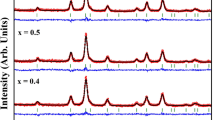Abstract
We investigated the size dependent magnetic properties and heating mechanism of spinel CoFe2O4 nanoparticles, which synthesized using the nonhydrolytic thermal decomposition method. The size of CoFe2O4 nanoparticles was arranged with the variation of solvent type, reflux time, and reflux temperature. The optimum size range was determined for magnetic fluid hyperthermia. The particles with 9.9 ± 0.3 nm average diameter have the highest heating ability in the AC magnetic field having 3.2 kA/m amplitude and 571 kHz frequency. The maximum specific absorption rate of 22 W/g was obtained for 9.9 ± 0.3 nm sized CoFe2O4 nanoparticles. The calculations and experimental results showed the dominancy of Brownian relaxation at the heat production of synthesized 9.9 ± 0.3 nm nanoparticles. In contrary, the magneto-heating in 5.4 ± 0.2 nm particles mainly originated from Neel relaxation.





Similar content being viewed by others
References
Coskun M, Can MM, Coskun OD, Korkmaz M, Firat T (2012) Surface anisotropy change of CoFe2O4 nanoparticles depending on thickness of coated SiO2 shell. J Nanopart Res 14:1197
Fortin J-P, Wilhelm C, Servais J, Ménager C, Bacri J-C, Gazeau F (2007) Size-sorted anionic iron oxide nanomagnets as colloidal mediators for magnetic hyperthermia. J Am Chem Soc 9(129):2628–2635
Häfeli U, Schütt W, Teller J, Zborowski M (1997) Scientific and clinical applications of magnetic carries. Plenum, New York
Hergt R, Dutz S (2007) Magnetic particle hyperthermia—biophysical limitations of a visionary tumour therapy. J Magn Magn Mater 311:187–192
Hergt R, Hiergeist R, Hilger I, Kaiser WA, Lapatnikov Y, Margel S, Richter U (2004) Maghemite nanoparticles with very high AC-losses for application in RF-magnetic hyperthermia. J Magn Magn Mater 270:345–357
Hergt R, Dutz S, Muller R, Zeisberger M (2006) Magnetic particle hyperthermia: nanoparticle magnetism and materials development for cancer therapy. J Phys 18:S2919–S2934
Johannsen M, Gneveckow U, Eckelt L, Feussner A, Waldöfner N, Scholz R, Deger S, Wust P, Loening SA, Jordan A (2005) Clinical hyperthermia of prostate cancer using magnetic nanoparticles: presentation of a new interstitial technique. Int J Hyperthermia 21:637–647
Lu A-H, Salabas EL, Schüth F (2007) Magnetic nanoparticles: synthesis, protection, functionalization, and application. Angew Chem Int Ed Engl 46:1222–1244
Moroz P, Jones SK, Gray BN (2002) Magnetically mediated hyperthermia: current status and future directions. Int J Hyperthermia 18:267–284
Pradhan P, Giri J, Samanta G, Sarma HD, Mishra KP, Bellare J, Banerjee R, Bahadur D (2007) Comparative evaluation of heating ability and biocompatibility of different ferrite-based magnetic fluids for hyperthermia application. J Biomed Mater Res B 1(81):12–22
Rosenzweig RE (1985) Ferrohydrodynamics. Cambridge University Press, Cambridge
Rosensweig RE (2002) Heating magnetic fluid with alternating magnetic field. J Magn Magn Mater 252:370–374
Shukla N, Liu C, Roy AG (2006) Oriented self-assembly of cubic FePt nanoparticles. Mater Lett 8(60):995–998
Sun S, Zeng H, Robinson DB, Raoux S, Rice PM, Wang SX, Li G (2004) Monodisperse MFe2O4 (M=Fe Co, Mn) nanoparticles. J Am Chem Soc 126:273–279
Wang X, Gu H, Yang Z (2005) The heating effect of magnetic fluids in an alternating magnetic field. J Magn Magn Mater 293:334–340
Xu C, Sun S (2007) Monodisperse magnetic nanoparticles for biomedical applications. Polym Int 56:821–826
Acknowledgments
This work was partially supported by The Scientific and Technological Research Council of Turkey (project number TBAG-109T746).
Author information
Authors and Affiliations
Corresponding author
Rights and permissions
About this article
Cite this article
Çelik, Ö., Can, M.M. & Firat, T. Size dependent heating ability of CoFe2O4 nanoparticles in AC magnetic field for magnetic nanofluid hyperthermia. J Nanopart Res 16, 2321 (2014). https://doi.org/10.1007/s11051-014-2321-6
Received:
Accepted:
Published:
DOI: https://doi.org/10.1007/s11051-014-2321-6




